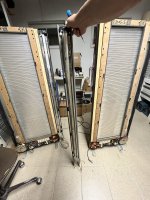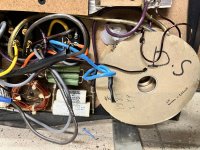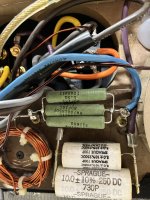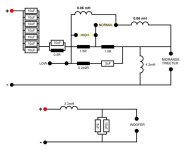Correct on the bass panel. The speaker are wired and verified to be configured for one ohm operation.From the picture Carlton these look like the 4 ohm version bass panels.
are you using the purifi amps to drive these at the 1 ohm strapping or the 4 ohm ?
Most of the class D amps spec 2 ohm ps limit so want to know any issues if you are driving them at
the 1 ohm setting
I thought the 1 ohm vs 4 ohm bass panel was determined by the physical structure of the panels ?Correct on the bass panel. The speaker are wired and verified to be configured for one ohm operation.
The 1///4 bass panel has the option to connect in series or parallel. Series configuration for 4 ohm versus parallel 1 ohm. Later versions were strictly 1 only with wider traces.
Found this link from the old Apogee Forum before it was shutdown. I was participating in the discussion under the moniker (ribbonrail)
http://www.apogeeacoustics.com/oldforum/003534.html
Found this link from the old Apogee Forum before it was shutdown. I was participating in the discussion under the moniker (ribbonrail)
http://www.apogeeacoustics.com/oldforum/003534.html
Last edited:
Looks like I gave the incorrect order of the Scintilla design.
From a review:
'I do not know the exact total number of Scintillas sold. It went
through four iterations. The first 40 pairs were made with 4 ohm
transformers. It was a disaster and we took back all of them. At the
time, we were using a formed plastic cover which we glued on and had no
idea how to remove it. It was not a fun time. I believe that the next
300 pairs were strictly 1ohm. At that point, we changed to the 1 ohm/4
ohm combination which remained until the end. I think that we produced
somewhere between 1500 2000 pairs in total
From a review:
'I do not know the exact total number of Scintillas sold. It went
through four iterations. The first 40 pairs were made with 4 ohm
transformers. It was a disaster and we took back all of them. At the
time, we were using a formed plastic cover which we glued on and had no
idea how to remove it. It was not a fun time. I believe that the next
300 pairs were strictly 1ohm. At that point, we changed to the 1 ohm/4
ohm combination which remained until the end. I think that we produced
somewhere between 1500 2000 pairs in total
Good job, very wel made !They do make excellent panels and a big thumbs up on offering diyers the option but find it a little boring with no learning
curve. Nothing beats a good challenge…
I have no illusions of making as good as their offerings, but at the end of the day it’s still a strip of foil in a magnetic gap
What I didn’t do on making the divas and scintilla panels that will be done here , is pre run a sheet thru the “machine” stretch out to a final lay pattern,
lay it against the magnet rows, mark the magnet centers on the strectched foil, then flatten the foil out again to mark the cut sheet
more out of curiosity more accuracy and a different approach then before.
Hi AVWERK,
Question:
I'm currently refurbishing a set of Apogee Duetta Signatures with lots of help from Rob Dingen. They are performing very well now after repairing the bass panels and replacement of the tweeters.


I've encountered a loose wire connected to the tweeter filter, it's connected to a series resistor and the other end of the resistor is connected to the ground rail of the tweeter filter. see attached pictures. I can't find this connection in the schematic, I was able to reverse all the modifications introduced by the former owner except this wire connection. I do see a similar resistor and wire in the picture shared in the thread about the Duetta bass panels above in the specific picture it's impossible to see the connection. Can you please tell me where this wire is connected in your apogee duetta?
Question:
I'm currently refurbishing a set of Apogee Duetta Signatures with lots of help from Rob Dingen. They are performing very well now after repairing the bass panels and replacement of the tweeters.


I've encountered a loose wire connected to the tweeter filter, it's connected to a series resistor and the other end of the resistor is connected to the ground rail of the tweeter filter. see attached pictures. I can't find this connection in the schematic, I was able to reverse all the modifications introduced by the former owner except this wire connection. I do see a similar resistor and wire in the picture shared in the thread about the Duetta bass panels above in the specific picture it's impossible to see the connection. Can you please tell me where this wire is connected in your apogee duetta?
Attachments
Based on a hunch here, I see non-standard apogee speaker cable in the mix (the clear stuff) so maybe the previous owner simply swapped for a different cable for some reason and used heat shrink on the loose one instead of removing it completely?
Yeah looked at the older photo above and it appears maybe at one point this person tried to run the MRTW ribbon active at some point or used an external XO.
That could be the case indeed, the former only did use an external filter passive or activeYeah looked at the older photo above and it appears maybe at one point this person tried to run the MRTW ribbon active at some point or used an external XO.
Thanks, do you have a clue what the purpose might be? Maybe an additional series resistor for extra tweeter attenuation?Same as my signatures. Zoom out and you see the heat shrink on the blue wire end
The Duettas have shaping circuit for flatening the TW response.
when driven bi - active ,with the blue wire the circuit remains for correct frequency response
At least as far as i know.
when driven bi - active ,with the blue wire the circuit remains for correct frequency response
At least as far as i know.
Well, the foil I asked for isn't an option, for a reason:
"Product: 1100 Aluminum Foil
Size: 0.001'' Thk x 18'' W x 100ft in coil
Tolerance: -0.0001" to 0.0001" Thk x -1/8" to 1/8" W x 0 ft. to 5 ft. L
Yield Strength: 20,000 psi
Fabrication: Cold Rolled
Temper: H19
Temper Rating: Full Hard
Heat Treatment: Hardened
Hardness: Brinell 45
Quantity: 1 pc
Unit Price: $790.00/pc (Total of $790.00)
Shipping & Handling: $60.00
Total Amount: $850.00"
And VAT wasn't even included!!!
"Product: 1100 Aluminum Foil
Size: 0.001'' Thk x 18'' W x 100ft in coil
Tolerance: -0.0001" to 0.0001" Thk x -1/8" to 1/8" W x 0 ft. to 5 ft. L
Yield Strength: 20,000 psi
Fabrication: Cold Rolled
Temper: H19
Temper Rating: Full Hard
Heat Treatment: Hardened
Hardness: Brinell 45
Quantity: 1 pc
Unit Price: $790.00/pc (Total of $790.00)
Shipping & Handling: $60.00
Total Amount: $850.00"
And VAT wasn't even included!!!
I don't know. The only supplier I can find who sells hard temper foil in small quantities is Grainger in the US.
I know that, but ordering to Finland seems to be impossible, Finland is not on the list of drop down menu. One possibility would be to use a courier, I would pay someone in the US to buy, and this person would send the package to Finland.
- Home
- Loudspeakers
- Planars & Exotics
- Anyone making Apogee bass panels?


